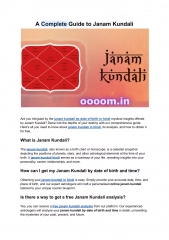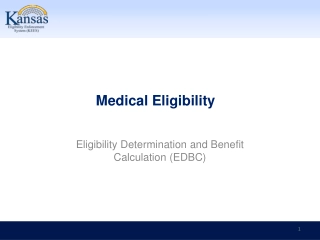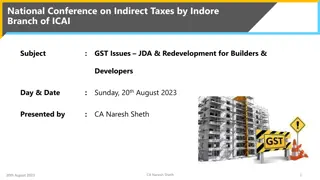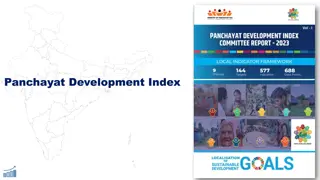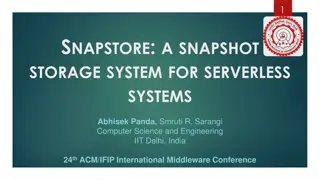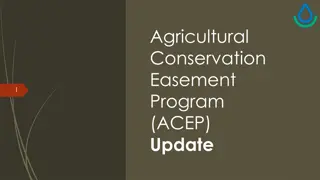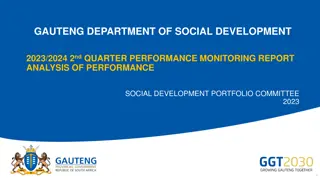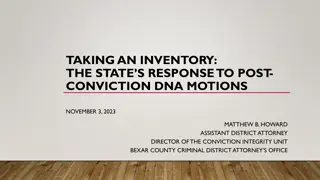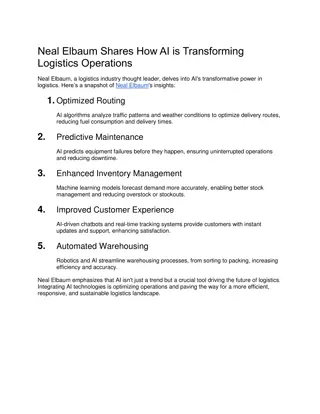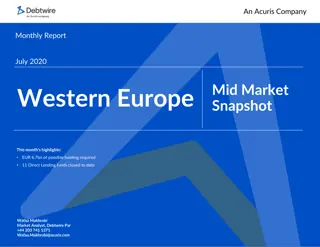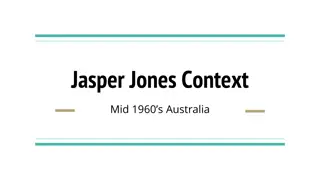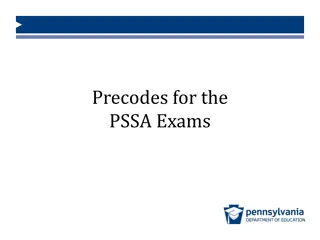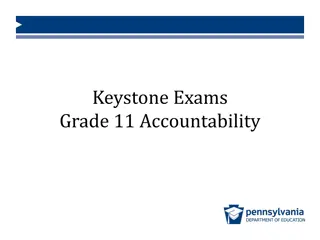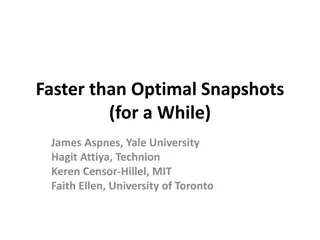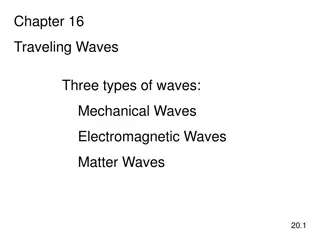
Expert Recommendations for TRK Fusion Sarcomas Diagnosis and Management
This publication provides expert recommendations from the World Sarcoma Network on the diagnosis and management of TRK fusion sarcomas, a rare subset of sarcomas. The article discusses the challenges in diagnosing NTRK gene fusions, outlines a diagnostic strategy, and offers practical guidance for integrating this biomarker into the clinical management of sarcoma patients.
Download Presentation

Please find below an Image/Link to download the presentation.
The content on the website is provided AS IS for your information and personal use only. It may not be sold, licensed, or shared on other websites without obtaining consent from the author. If you encounter any issues during the download, it is possible that the publisher has removed the file from their server.
You are allowed to download the files provided on this website for personal or commercial use, subject to the condition that they are used lawfully. All files are the property of their respective owners.
The content on the website is provided AS IS for your information and personal use only. It may not be sold, licensed, or shared on other websites without obtaining consent from the author.
E N D
Presentation Transcript
PUBLICATION SNAPSHOT #4 Assoc. Prof. Tracy Stockley Head of Clinical Laboratory Genetics, University Health Network, Toronto; Dept of Laboratory Medicine and Pathobiology University of Toronto, Canada 2
DISCLAIMER Please note: Views expressed within this presentation are the personal opinions of the author. They do not necessarily represent the views of the author s academic institution or the rest of NTRK CONNECT group. This content is supported by an independent educational grant from Bayer. Disclosures: Assoc. Prof. Tracy Stockley has received honoraria from the following: Astellas, AstraZeneca, Bristol Myers Squibb, Janssen, Novartis 3
DIAGNOSIS AND MANAGEMENT OF TRK FUSION SARCOMAS: EXPERT RECOMMENDATIONS FROM THE WORLD SARCOMA NETWORK Demetri GD, et al. Ann Oncol. 2020; doi: 10.1016/j.annonc.2020.08.2232 TRK, tropomyosin receptor kinase 4
BACKGROUND: HIGH UNMET NEED FOR PATIENTS WITH ADVANCED/METASTATIC SARCOMAS Sarcoma Sites Sarcomas: For localised setting: curative management = Complete resection (with or without radiation and/or chemotherapy) For locally advanced or metastatic disease, or those with disease recurrence following surgery: treatment options = systemic therapy radiation, isolated limb perfusion, surgery, and ablation techniques The median overall survival of patients with advanced soft tissue sarcomas = 20 months 1% of all adult cancers (=rare cancer) 20% of all paediatric solid tumours Bone (20%) Soft tissue (80%) Skull Head/neck Thorax, trunk, abdomen and upper limb Ribs Long bones of upper limb Uterus, pelvis Bladder Lower bones, hips Long bones of lower limb 5
OBJECTIVE OF THE PAPER NTRK gene fusions discovered as pan-tumour oncogenic drivers New precision medicine-based treatment options for a subset of patients with sarcoma appeared NTRK gene fusions are rare and diagnostic is complex Clinicians have several questions and challenges 1. Convened two consensus meetings with expert adult oncologists and pathologists * 2. Discuss diagnostic challenges and propose a diagnostic strategy in this area To provide practical guidance on how to optimally integrate the NTRK gene fusion biomarker into the clinical management of patients with sarcoma OBJECTIVE * World Sarcoma Network (WSN) is a cooperative group gathering the main reference centres for sarcomas around the World dedicated to the development and the support of innovative and collaborative clinical trials and to the drug development in sarcomas NTRK, neurotrophic receptor tyrosine kinase 6
FREQUENCY OF NTRK GENE FUSIONS BY SARCOMA SUBTYPES: LITERATURE SEARCH (1/2) Study Testing method Proportion of NTRK fusions identified, % (n/N) NTRK fusion-positive sarcoma subtypes NTRK genes and fusion partners involved Agaram NP, et al. 2016 FISH, RNA MPS 71 (10/14) Lipofibromatosis like neural tumour 1x TPR-NTRK1, 1x TPM3-NTRK1, 4x LMNA-NTRK1 Bourgeois JM, et al. 2000 RT-PCR 91 (10/11) IFS ETV6-NTRK3 Bui NQ, et al. 2019 Targeted DNA MPS 0.7 (1/152) Myopericytoma NR Chang JC, et al. 2019 Targeted RNA MPS 33 (3/9) IMT ETV6-NTRK3 Chmielecki J, et al. 2017 Targeted RNA MPS 1 (4/324) 2x IFS, 1x assorted soft tissue sarcoma, 1x hemangioma, 1x bone sarcoma 1x SQSTM1-NTRK1, other fusions partners NR Church AJ, et al. 2018 FISH 96% (25/26) IFS NTRK3 Croce S, et al. 2019 Targeted RNA MPS 54 (7/13) Uterine and vaginal sarcomas resembling fibrosarcoma 6x TPM3-NTRK1, 1x EML4-NTRK3 Gatalica Z, et al. 2018 Targeted RNA MPS 0.4 (2/478) 1x STS, 1x uterine sarcoma 1x TPM3-NTRK1, 1x SPECC1L-NTRK3 Rosen EY, et al. 2020 Targeted RNA MPS 1 (11/944) Sarcoma NOS (9/770 [1%]), uterine sarcoma (2/174 [1%]) NR Shi E, et al. 2016 Targeted DNA MPS 0.5 (1/186) overall (4 [1/24] in quadnegative tumours) GIST ETV6-NTRK3 Stransky N, et al. 2014 TCGA RNAseq dataset 1 (1/103) Sarcoma TPM3-NTRK1 FISH, fluorescence in situ hybridisation; GIST, gastrointestinal stromal tumour; IFS, infantile fibrosarcoma; IMT, inflammatory myofibroblastic tumour; MPS, massive parallel sequencing; NOS, not otherwise specified; NR, not reported; NTRK, neurotrophic receptor tyrosine kinase; RT-PCR, reverse transcription polymerase chain reaction; STS, soft tissue sarcoma; TCGA, The Cancer Genome Atlas 7
FREQUENCY OF NTRK GENE FUSIONS BY SARCOMA SUBTYPES: LITERATURE SEARCH (2/2) Study Testing method Proportion of NTRK fusions identified, % (n/N) 0.7% (13/1,915) NTRK fusion-positive sarcoma subtypes NTRK genes and fusion partners involved Additional outcomes from literature search Solomon JP, et al. 2020 Targeted DNA and/or RNA MPS 2x IFS, 2x lipofibromatosis like neural tumour, 2x uterine sarcoma, 1x uterine high grade pleomorphic sarcoma, 1x high grade spindle cell sarcoma, 1x malignant spindle cell sarcoma, 1x spindle cell sarcoma, 1x angiosarcoma, 1x S 100 positive malignant spindle cell neoplasm, 1x low grade sarcoma IMT 4x LMNA-NTRK1, 3x TPM3-NTRK1, 2x ETV6-NTRK3, 1x TPR-NTRK1, 1x TPM4- NTRK3, 1x EEF1A1-NTRK3, 1x PEAR1-NTRK1 A significant number of NTRK fusion-positive sarcomas show co-expression of S100 protein and CD34 However the rest have a non- specific immunophenotype 18% (3/17) ETV6-NTRK3 Surrey LF, et al. 2019 Targeted RNA MPS 4% (2/45) Sarcomas (other) 1x TFG-NTRK3, 1x RBPMS-NTRK3 Suurmeijer AJH, et al. 2018 FISH, targeted RNA MPS 60% (15/25) Malignant peripheral nerve sheath tumour-like 8x LMNA-NTRK1, 3x TPM3-NTRK1, 1x SPECC1L-NTRK2, 1x TPR-NTRK1, 2x NTRK1 with unknown fusion partners ETV6-NTRK3 The published literature on NTRK gene fusion frequency in sarcomas is limited and more data are needed Yamamoto H, et al. 2020 MPS (TBC), IHC 5% (2/40) IMT Zhu G, et al. 2019 Targeted RNA MPS 3% (5/184) 2x lipofibromatosis-like neural tumour, 1x IFS, 1x IMT, 1x sarcoma NOS 2x ETV6-NTRK3, 2x TPM3-NTRK1, 1x LMNA-NTRK1 FISH, fluorescence in situ hybridisation; IFS, infantile fibrosarcoma; IHC, immunohistochemistry; IMT, inflammatory myofibroblastic tumour; MPS, massive parallel sequencing; NOS, not otherwise specified; NTRK, neurotrophic receptor tyrosine kinase; TBC, to be confirmed 8
TARGETED THERAPY FOR NTRK GENE FUSION POSITIVE SARCOMAS IS EFFECTIVE Clinical development programme with larotrectinib Clinical development programme with entrectinib Adult in Phase 1 Advanced solid tumours NCT02122913 Paediatric in phase 1/2 Advanced solid tumours SCOUT: NCT02637687 Adult/adolescent in Phase 2 Advanced solid tumours NAVIGATE: NCT02576431 ALKA-372-001: Phase 1 Solid tumours EudraCT 2012-000148-88 STARTRK-1: phase 1 Solid tumours NCT02097810 STARTRK-2: Phase 2 Solid tumours NCT02568267 1 2 51 12 50 97 Patients: Patients: Data cutoff: 19 February 20191 Data cutoff: 31 May 20182 Total of 159 patients with TRK fusion solid tumour Total of 54 adults with advanced or metastatic TRK fusion solid tumour 71 (~45% ) patients with TRK fusion sarcomas 13 (24%) patients with TRK fusion sarcomas TRK fusion sarcomas treated with larotrectinib (n=71) TRK fusion sarcomas treated with entrectinib (n=13) Parameters Parameters ORR, % 87 (95% CI 77-94) ORR, % 46 (95% CI 19-75) Median DoR, months NE (range 1.6+ to 44.2+) Median DoR, months 10.3 (95% CI 4.6-15.0) Median PFS, months 28.3 (95% CI 16.8-NE) Median PFS, months 11.0 (95% CI 6.5-15.7) Median OS, months 44.4 (95% CI 44.4-NE) Median OS, months 16.8 (95% CI 10.6-20.9) CI, confidence interval; DoR, duration of response; NE, not estimable; NTRK, neurotrophic receptor tyrosine kinase; ORR, objective response rate; OS, overall survival; PFS, progression-free survival; TRK, tropomyosin receptor kinase 1. Hong DS, et al. Lancet Oncol. 2020;21(4):531-40; 2. Doebele RC, et al. Lancet Oncol. 2020;21(2):271-82 9
CURRENT METHODS TO TEST NTRK GENE FUSIONS: ADVANTAGES AND DISADVANTAGES FISH IHC RT-PCR MPS Available in many clinical laboratories Widely available Widely available Allows simultaneous detection of fusions between NTRK1-3 and any number of known or novel fusion partner genes Advantages Rapid turnaround time Rapid turnaround time Rapid turnaround time Inexpensive Inexpensive Allows identification of specific cell types harbouring the NTRK fusion Relatively inexpensive Requires specific expertise Detection of wild-type protein expression, especially in tumours with neural and myogenic differentiation Requires knowledge of fusion partner gene sequence Not routinely conducted in all clinical laboratories False negativity rate of 30% Relatively long turnaround time Disadvantages Challenging to test for fusions involving multiple NTRK and fusion partner genes in parallel Relatively expensive False negativity rate of ~10% Does not distinguish between in-frame and out-of-frame fusion events DNA MPS may miss NTRK2 and NTRK3 fusions due to large introns this rate may be higher in tumours harbouring NTRK3 fusions RNA MPS requires high quality RNA Variable detection rates of different panels May identify non oncogenic NTRK rearrangements FISH, fluorescence in situ hybridisation; IHC, immunohistochemistry; MPS, massive parallel sequencing; NTRK, neurotrophic receptor tyrosine kinase; RT-PCR, reverse transcription polymerase chain reaction 10
TESTING ALGORITHM PROPOSAL FOR NTRK GENE FUSIONS IN SARCOMAS Tumour sample Histologic diagnosis of sarcoma NTRK fusion Testing Localised disease Locally advanced and unresectable or metastatic disease No routine NTRK testinga In primary, resectable sarcomas not necessary +++ + ++ NTRK testing priority For patients at high risk of relapse might provide clinically actionable information for later in the disease course Sarcomas with recurrent gene fusions KIT, PDFGR, SDH, NF1, or BRAF- altered GIST MDM2/CDK4-amplified LPS Sarcomas with high frequency of NTRK fusions IFS IMT Sarcomas with low frequency of NTRK fusions Sarcomas with complex genomics Wild-type GIST For patients with locally advanced, unresectable tumours Should be performed NTRK testing for research only Pan-TRK IHC1 FISH Pan-TRK IHC Negativeb Positivec Negative Positive Consider MPS panel including NTRK and non-NTRK alterations For patients with metastatic disease failing conventional therapies Should be performed No additional NTRK testing MPS Negative Negative Positive Positived Consider TRK inhibitor aFor patients at high risk of relapse, NTRK gene fusion testing might provide clinically actionable information for later in the disease course. bIf histology is typical then confirmation by MPS is recommended. cTreatment may be considered concurrently with confirmatory MPS. dConsider parallel validation by MPS or RT-PCR to confirm that fusion is in-frame. Avoid IHC screening in cases with myogenic and neural differentiation due to the high rate of false positivity. FISH, fluorescence in situ hybridization; GIST, gastrointestinal stromal tumour; IFS, infantile fibrosarcoma; IHC, immunohistochemistry; IMT, inflammatory myofibroblastic tumour; LPS, liposarcoma; MPS, massive parallel sequencing; NTRK, neurotrophic tyrosine receptor kinase; RT-PCR, reverse transcription polymerase chain reaction; TRK, tropomyosin receptor kinase. 11
CONCLUSIONS AND DISCUSSION Conclusions First diagnostic proposal in sarcoma taking into account disease stage and histologic and molecular subtypes Provides algorithms for diagnostic testing, including how massive parallel sequencing (MPS) is best used in sarcomas to ensure cost-effectiveness Immunohistochemistry (IHC) provides a valuable pre-screening tool prior to MPS panels Discussion Further research is necessary to fully establish the sensitivity and specificity of pan-TRK IHC Multinational comparative studies to increase the reproducibility of MPS assays Prospective studies critical to determine the frequency of NTRK gene fusions in different sarcoma subtypes and correlation with morphological, biological, and clinical features The same approaches should be undertaken in all relevant solid advanced tumours where TRK inhibitors are effective in order to build an effective diagnostic strategy NTRK, neurotrophic receptor tyrosine kinase; TRK, tropomyosin receptor kinase 12
REACH NTRK CONNECT VIA TWITTER, LINKEDIN, VIMEO & EMAIL OR VISIT THE GROUP S WEBSITE http://www.ntrkconnect.info Follow the NTRK CONNECT group on LinkedIn Watch us on the Vimeo Channel NTRK CONNECT Email Follow us on Twitter @ntrkconnectinfo froukje.sosef @cor2ed.com 13
NTRK CONNECT Bodenackerstrasse 17 4103 Bottmingen SWITZERLAND Dr. Froukje Sosef MD +31 6 2324 3636 froukje.sosef@cor2ed.com Dr. Antoine Lacombe Pharm D, MBA +41 79 529 42 79 antoine.lacombe@cor2ed.com Heading to the heart of Independent Medical Education Since 2012

